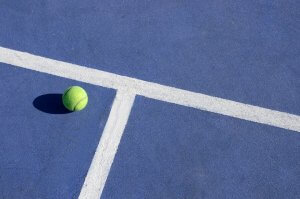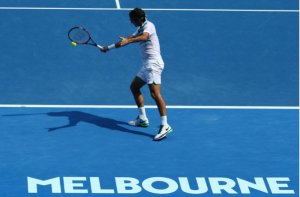Characteristics of Different Types of Tennis Courts

Currently, the International Federation of Tennis officially approves three types of tennis courts for the sport. In this article, you’ll learn what types of court surfaces there are for playing both singles and doubles tennis.
Dimensions and characteristics of tennis courts
Besides the types of materials used for tennis court surfaces, there are specific measurements they must all adhere to. Tennis courts are exactly 23.77 meters long and 8.23 meters wide for singles, or 10.97 meters wide for doubles.
Each tennis court must have extra space outside: 6.4 meters behind, and 3.65 meters to the side. The net in the middle of the court must be exactly 0.91 meters tall.
Tennis courts divide into two equal parts, one for each player or team of players. On each side, there are serving squares (4.11 meters wide and 5.49 meters long) and two rectangular sectors flanking the net of 6.4 meters long.
The three types of tennis courts
Many years ago, officials allowed five different types of surfaces, but they decided to prohibit carpet, and wood surfaces are not used anymore (both of these were for indoor games). Currently, they allow three different types of surfaces, and they’re all for outdoors.
1. Grass court
The grass-court is the type of surface used for the fastest games. The most well-known is Wimbledon, in England. The other types are Halle, Stuttgart, Newport, and Antalya. Not very many places use it for tournaments since it’s expensive to maintain and to install.

Grass courts need a special watering and draining system to avoid flooding; they also need a type of grass that’s appropriate for the climate. It must be removed and replanted every once in a while, as well.
The main characteristic of this type of court is that the bounce of the ball is irregular, low, and fast. It can change height and direction without warning.
Some of the Wimbledon legends have been able to negotiate those difficult bounces such as Martina Navratilova, Roger Federer, Bjorn Borg, Billie Jean King, Serena Williams, and Rod Laver.
2. Hardcourt
Hardcourt tennis courts are made of cement, asphalt, or plastic, and they allow for semi-rapid speeds (less than grass courts). The players who have the biggest advantages out of this surface type are those who have powerful, strong serves.
Both the US Open and the Australia Open use this type of court (acrylic and synthetic, respectively). In order to make these types of court they use sand; the density of the material determines the speed of the bounce.

Some tennis legends that have excelled in beating the challenges of this type of court are Margaret Court, Martina Navratilova, Rafael Nadal, Jamie Murray, Novak Djokovic, Rod Laver, Roy Emerson, Pete Sampras, and Roger Federer.
3. Clay court
Also known as brick dust, clay courts are both the slowest and the most popular. It’s a characteristic red color, and Roland Garros chose this surface for the Grand Slam players. This type of game is usually defensive because the players “skate” over the clay and tend to stay on the backline.
The most successful player for this French tournament was the Belgian player Justine Henin, with four titles. For men, the Spaniard Rafael Nadal has achieved no less than 12 titles.

Other tennis players that have previously enjoyed playing on this type of court are the Australian Roy Emerson, the French player Suzanne Lenglen, the American Chris Evert, and the German Steffi Graf.
The novelty when it comes to colors presented itself in the Masters of Madrid in 2012: blue clay. More importantly than the color, officials concluded that the bounce of the ball was not affected. In the United States, you can find green clay courts, and Charleston is one of the tournaments that use it.
In the majority of cases, tennis players begin on clay courts, then try synthetic ones, and finally end up on a grass court. However, some of them specialize in a special type of court from the beginning.
Currently, the International Federation of Tennis officially approves three types of tennis courts for the sport. In this article, you’ll learn what types of court surfaces there are for playing both singles and doubles tennis.
Dimensions and characteristics of tennis courts
Besides the types of materials used for tennis court surfaces, there are specific measurements they must all adhere to. Tennis courts are exactly 23.77 meters long and 8.23 meters wide for singles, or 10.97 meters wide for doubles.
Each tennis court must have extra space outside: 6.4 meters behind, and 3.65 meters to the side. The net in the middle of the court must be exactly 0.91 meters tall.
Tennis courts divide into two equal parts, one for each player or team of players. On each side, there are serving squares (4.11 meters wide and 5.49 meters long) and two rectangular sectors flanking the net of 6.4 meters long.
The three types of tennis courts
Many years ago, officials allowed five different types of surfaces, but they decided to prohibit carpet, and wood surfaces are not used anymore (both of these were for indoor games). Currently, they allow three different types of surfaces, and they’re all for outdoors.
1. Grass court
The grass-court is the type of surface used for the fastest games. The most well-known is Wimbledon, in England. The other types are Halle, Stuttgart, Newport, and Antalya. Not very many places use it for tournaments since it’s expensive to maintain and to install.

Grass courts need a special watering and draining system to avoid flooding; they also need a type of grass that’s appropriate for the climate. It must be removed and replanted every once in a while, as well.
The main characteristic of this type of court is that the bounce of the ball is irregular, low, and fast. It can change height and direction without warning.
Some of the Wimbledon legends have been able to negotiate those difficult bounces such as Martina Navratilova, Roger Federer, Bjorn Borg, Billie Jean King, Serena Williams, and Rod Laver.
2. Hardcourt
Hardcourt tennis courts are made of cement, asphalt, or plastic, and they allow for semi-rapid speeds (less than grass courts). The players who have the biggest advantages out of this surface type are those who have powerful, strong serves.
Both the US Open and the Australia Open use this type of court (acrylic and synthetic, respectively). In order to make these types of court they use sand; the density of the material determines the speed of the bounce.

Some tennis legends that have excelled in beating the challenges of this type of court are Margaret Court, Martina Navratilova, Rafael Nadal, Jamie Murray, Novak Djokovic, Rod Laver, Roy Emerson, Pete Sampras, and Roger Federer.
3. Clay court
Also known as brick dust, clay courts are both the slowest and the most popular. It’s a characteristic red color, and Roland Garros chose this surface for the Grand Slam players. This type of game is usually defensive because the players “skate” over the clay and tend to stay on the backline.
The most successful player for this French tournament was the Belgian player Justine Henin, with four titles. For men, the Spaniard Rafael Nadal has achieved no less than 12 titles.

Other tennis players that have previously enjoyed playing on this type of court are the Australian Roy Emerson, the French player Suzanne Lenglen, the American Chris Evert, and the German Steffi Graf.
The novelty when it comes to colors presented itself in the Masters of Madrid in 2012: blue clay. More importantly than the color, officials concluded that the bounce of the ball was not affected. In the United States, you can find green clay courts, and Charleston is one of the tournaments that use it.
In the majority of cases, tennis players begin on clay courts, then try synthetic ones, and finally end up on a grass court. However, some of them specialize in a special type of court from the beginning.
All cited sources were thoroughly reviewed by our team to ensure their quality, reliability, currency, and validity. The bibliography of this article was considered reliable and of academic or scientific accuracy.
-
Rafael Plaza. 2017. ¿Es la hierba de Wimbledon más lenta que la tierra de Roland Garros? El español. https://www.elespanol.com/deportes/tenis/20170707/229477972_0.html
This text is provided for informational purposes only and does not replace consultation with a professional. If in doubt, consult your specialist.








